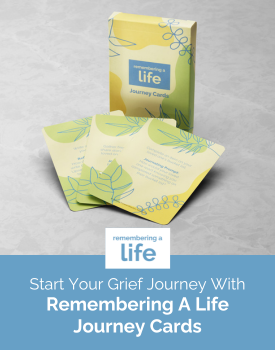When I wrote my first blog post on the novel coronavirus for Remembering a Life, “Loss in a Pandemic: Funeral Planning” ten days ago, there were approximately 8,000 confirmed cases of COVID-19 in the United States. As I write this piece, there are over 113,000 test-positive cases and more than 2,000 deaths in the U.S. thus far. And while the news ticker on every media outlet is constantly updating these numbers in real time, it can be challenging and overwhelming to conceptualize both the scope of death losses that will occur before the threat of this pandemic recedes as well as the weight of the secondary losses we are all experiencing.
Every one of us is living in an unsettling and uncertain cultural space right now – we may be caught between anticipatorily fearing becoming sick or losing a loved one to this virus while also grappling with real-time non-death losses that are impacting us in ways that are often overlooked.
We cannot confidently predict the duration of the pandemic and its potential long-term impact on ourselves or our loved ones, but for our own stability and the emotional well-being of those we care about, it is crucial that, in the current moment, we are able to:
- Identify and validate the secondary losses we and others are experiencing in real time;
- Recognize the grief responses we and loved ones are feeling; and
- Demonstrate care for ourselves and others.
Secondary Losses in Pandemic
Collectively and individually, we are experiencing a number of non-death losses secondary to this pandemic, from concrete losses such as financial stability, employment insecurity, and social interaction, to amorphous losses such as the comfort of our normal routines and our freedom of movement.
Importantly, we may also be experiencing the losses of our "assumptive world" – the set of core beliefs that stabilize, ground, and orient people and make them feel secure in their daily lives. Pandemic, like other forms of traumatic and mass casualty events, can threaten our belief that the world is or ever will be a safe and secure place.
For persons who do not live with underlying mental health conditions, the emotional effects of these losses can be new and disturbing. For individuals who already live with clinical depression, anxiety disorders, or other mental health challenges, these effects have the potential to be crippling.
Grief and Non-Death Losses
After a loved one has died, our individual emotional reactions to the loss, termed grief, are generally well-recognized. We know that after a death, it is common to experience many different emotions, commonly including anger, guilt, sadness, depression, loneliness, hopelessness, and numbness.
As you read these grief responses, some or all of them might resonate with you at this time. And that would make a lot of sense. Simply put, we are all individually experiencing grief in this pandemic, whether we have recently lost a loved one to death or not.
We are grieving our secondary losses. We are grieving for the risks and stressors experienced by others in our lives. We are grieving the losses of our assumptive worlds. And we are navigating a time of immeasurable unpredictability, which can complicate our grieving.
Identifying and Validating Secondary Losses
Loss and suffering cannot be quantified, though in American culture, there is a deeply-embedded learned behavior of ranking our grief against others’ and putting even physical pain on a subjective scale of 1-10. Phrases like “other people have it worse than I do” or “at least I’m not experiencing X or Y” are common, but rather than using them to put our losses in perspective, they frequently signal that we are obscuring and failing to recognize the impact of our personal experiences of loss, either out of guilt that we shouldn’t “complain” or out of fear of being criticized.
I encourage you to create a written inventory of your secondary losses in this pandemic – both large and small. Consider keeping a journal over the coming weeks and months and checking in with the losses you’ve written and add any that you experience in the future. Suggest to family members, including children, that they do the same.
It is helpful to identify the losses that might be triggering the emotions you are feeling during this health crisis, and it is also essential to validate that these losses are real. Whether or not there are people in your life who would judge your experiences right now as being less grave or life-threatening than others’ losses, they deserve to be validated, which will not be possible if you do not recognize them yourself.
Recognizing Grief Responses
Our grief experiences after a death or non-death loss often involve emotions including anger, guilt, sadness, depression, loneliness, hopelessness, and numbness. But when grief is not openly acknowledged, socially validated, or publicly observed, the person experiencing loss may experience disenfranchised grief. Emotional responses in persons experiencing disenfranchised grief often also involve feelings of powerlessness and helplessness.
Many losses that occur secondary to a death loss, as well as most non-death losses, are disenfranchised. For example, the grief of someone experiencing sudden job loss and subsequent financial emergency may not be recognized compared to that of a person who is grieving the loss of a loved one to death.
As another example from this cultural moment, the emotional responses of someone who is experiencing mental health losses as a result of chaos and isolation are not validated in the ways that the emotional responses of a person who is diagnosed with COVID-19 may be recognized. All of these persons are experiencing and grieving their unique collection of tangible and intangible losses, but only some will receive acknowledgment in their grief.
Demonstrating Care
If we are able to identify our many individually-experienced losses through the duration of this health crisis, we may better navigate the difficult months ahead. In recognizing our own emotional reactions as grief responses and allowing others to do the same, we can move forward more capably with our experiences in this pandemic. That will only be possible if we demonstrate care for ourselves while demonstrating care for the people who are important to us.
Care is both a noun and verb; it is not simply a feeling but also something we do. Showing care for others’ emotional reactions to the losses they are experiencing in this time will allow us to bear witness to others’ unique challenges and hardships, strengthen our bonds with our loved ones, and alleviate the risk of harmful effects on our mental and emotional health.
Ultimately, if we are able to recognize and share our emotional responses with one another, without fear of judgment, ranking, or disenfranchisement, we can combat the emotional effects of isolation and instead, become a supportive and resilient community of grievers.


